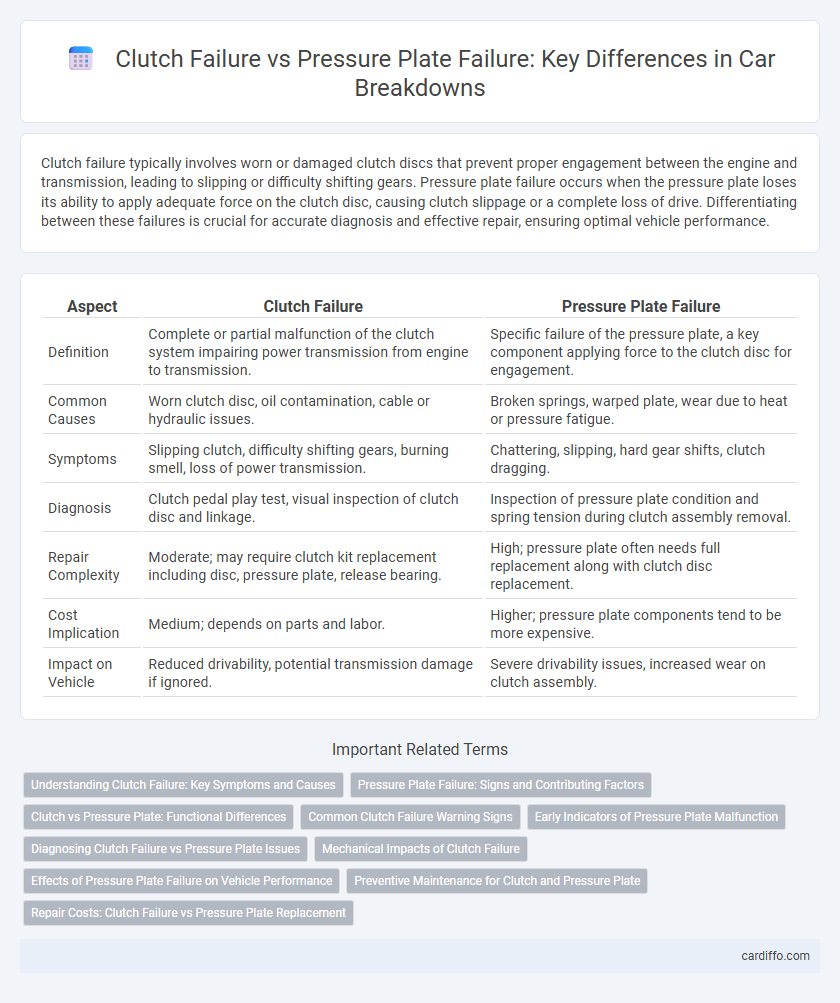Clutch failure typically involves worn or damaged clutch discs that prevent proper engagement between the engine and transmission, leading to slipping or difficulty shifting gears. Pressure plate failure occurs when the pressure plate loses its ability to apply adequate force on the clutch disc, causing clutch slippage or a complete loss of drive. Differentiating between these failures is crucial for accurate diagnosis and effective repair, ensuring optimal vehicle performance.
Table of Comparison
| Aspect | Clutch Failure | Pressure Plate Failure |
|---|---|---|
| Definition | Complete or partial malfunction of the clutch system impairing power transmission from engine to transmission. | Specific failure of the pressure plate, a key component applying force to the clutch disc for engagement. |
| Common Causes | Worn clutch disc, oil contamination, cable or hydraulic issues. | Broken springs, warped plate, wear due to heat or pressure fatigue. |
| Symptoms | Slipping clutch, difficulty shifting gears, burning smell, loss of power transmission. | Chattering, slipping, hard gear shifts, clutch dragging. |
| Diagnosis | Clutch pedal play test, visual inspection of clutch disc and linkage. | Inspection of pressure plate condition and spring tension during clutch assembly removal. |
| Repair Complexity | Moderate; may require clutch kit replacement including disc, pressure plate, release bearing. | High; pressure plate often needs full replacement along with clutch disc replacement. |
| Cost Implication | Medium; depends on parts and labor. | Higher; pressure plate components tend to be more expensive. |
| Impact on Vehicle | Reduced drivability, potential transmission damage if ignored. | Severe drivability issues, increased wear on clutch assembly. |
Understanding Clutch Failure: Key Symptoms and Causes
Clutch failure often manifests through symptoms such as slipping, difficulty in gear engagement, and unusual noises, primarily caused by worn friction material, oil contamination, or heat damage. Pressure plate failure specifically results from weakened springs or warped components that reduce clamping force, leading to incomplete clutch disengagement and vibration during operation. Identifying these key symptoms allows for accurate diagnosis and targeted repair to restore optimal vehicle performance.
Pressure Plate Failure: Signs and Contributing Factors
Pressure plate failure manifests through symptoms like clutch slippage, difficulty in shifting gears, and unusual noises during clutch engagement, often due to worn or broken springs and diaphragm fatigue. Contributing factors include excessive heat from prolonged clutch slipping, aggressive driving habits, and lack of proper maintenance, which accelerate wear and reduce pressure plate effectiveness. Identifying these signs early helps prevent complete clutch system failure and costly repairs.
Clutch vs Pressure Plate: Functional Differences
Clutch failure primarily affects the engagement and disengagement of power transmission between the engine and the drivetrain, while pressure plate failure impacts the clamping force required to keep the clutch disc pressed against the flywheel. The clutch system relies on the pressure plate to maintain friction and transfer torque efficiently, making damage to the pressure plate a critical factor in overall clutch performance. Understanding the functional distinction between clutch and pressure plate failures helps diagnose issues related to slipping, difficulty shifting, or abnormal noise in manual transmission vehicles.
Common Clutch Failure Warning Signs
Clutch failure commonly presents warning signs such as difficulty shifting gears, a spongy or sticking clutch pedal, and unusual noises when engaging or disengaging the clutch. Pressure plate failure often causes similar symptoms but may include excessive pedal vibrations and a clutch pedal that feels abnormally stiff or loose. Recognizing these indicators early can prevent further transmission damage and costly repairs.
Early Indicators of Pressure Plate Malfunction
Early indicators of pressure plate malfunction include unusual vibrations or chatter during clutch engagement, difficulty shifting gears, and a spongy or stiff clutch pedal feel. These symptoms often precede clutch failure and signal that the pressure plate's diaphragm springs or friction surface may be compromised. Identifying these signs early helps prevent complete clutch system breakdown and costly repairs.
Diagnosing Clutch Failure vs Pressure Plate Issues
Diagnosing clutch failure involves examining symptoms such as slipping, difficulty shifting gears, and unusual noises, while pressure plate issues often manifest as vibration, clutch drag, or disengagement problems. A thorough inspection includes checking for wear on the clutch disc, pressure plate surface damage, and hydraulic system integrity to pinpoint the exact cause. Proper diagnosis ensures targeted repairs, avoiding unnecessary replacement of the entire clutch assembly.
Mechanical Impacts of Clutch Failure
Clutch failure primarily results in the inability to disengage the engine from the transmission, causing mechanical stresses such as gear grinding, increased transmission wear, and potential drivetrain damage. Pressure plate failure manifests as insufficient clamping force, leading to slippage, overheating, and accelerated wear of the friction disc. These mechanical impacts reduce overall vehicle performance, increase repair costs, and shorten the lifespan of transmission components.
Effects of Pressure Plate Failure on Vehicle Performance
Pressure plate failure directly compromises clutch engagement, causing slipping, difficulty in gear shifting, and reduced power transmission to the wheels. This results in decreased acceleration, inconsistent vehicle response, and potential damage to the flywheel and clutch disc. Persistent pressure plate issues often lead to complete clutch malfunction, necessitating immediate repair to restore optimal vehicle performance.
Preventive Maintenance for Clutch and Pressure Plate
Regular inspection and timely replacement of clutch components and pressure plates significantly reduce the risk of mechanical failures and extend vehicle lifespan. Monitoring wear indicators, adjusting pedal free play, and ensuring proper hydraulic fluid levels help maintain optimal clutch performance. Implementing routine preventive maintenance schedules minimizes costly breakdowns and enhances overall drivetrain reliability.
Repair Costs: Clutch Failure vs Pressure Plate Replacement
Repair costs for clutch failure typically range from $800 to $1,500, depending on labor intensity and parts quality, while pressure plate replacement alone generally costs between $400 and $700. Clutch failure often requires replacing multiple components, including the pressure plate, clutch disc, and release bearing, increasing the total expense significantly. Pressure plate failure as an isolated issue results in lower repair costs due to fewer parts and reduced labor time.
Clutch failure vs pressure plate failure Infographic

 cardiffo.com
cardiffo.com